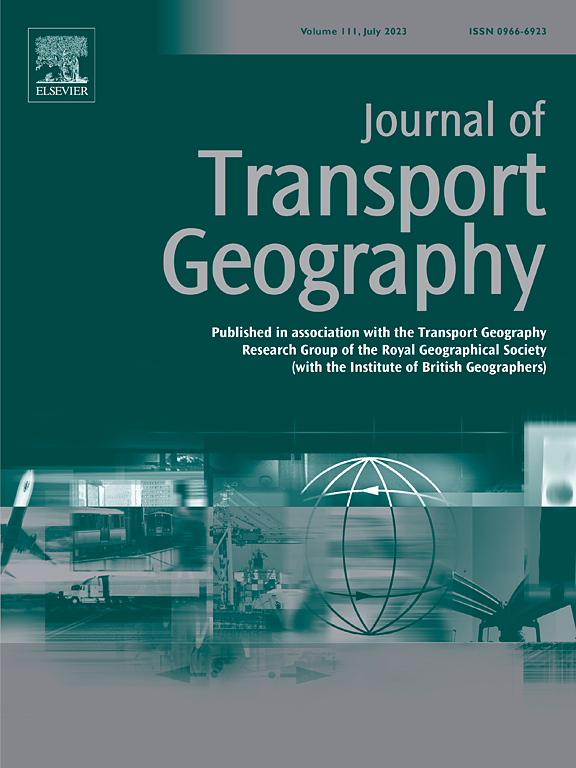BikeshareGAN: Predicting dockless bike-sharing demand based on satellite image
IF 5.7
2区 工程技术
Q1 ECONOMICS
引用次数: 0
Abstract
Understanding the drop-off demand of Dockless Bikeshare Systems (DBS) is crucial for efficient urban management but has long been challenging. Conventional prediction models are mostly regression-based, requiring multisource and fine-grained GIS data (e.g., socio-demographics, land use, POI), whose collection could be laborious and costly. Some data do not even exist for fast-growing cities in the developing world, largely hindering the application of the conventional models. Noting that high dimensional satellite images contain rich data about complex urban systems (e.g., density, land use, transportation network), we hypothesize that Generative Adversarial Networks (GAN) can embed inherent urban features as the latent space, to predict DBS demand directly from satellite images effectively. To test the hypothesis, we took Shenzhen - a city with diverse urban forms as a case study. Pairwise satellite image and DBS drop-off heatmap during AM/PM and non-peak hours on a random workday became the input and output images for Pix2Pix, a proven GAN framework, to train the image-to-image translation at the 200 m level. Fake heatmaps were generated and validated by ground truth using loss functions including L1, L2, and Structure Similarity Index Measure (SSIM). R2 was also calculated to compare our pixelated results to conventional regression models. First, simply taking a satellite image as the input achieved ∼0.49 R2 (82 % SSIM), outperforming many regression-based models that require a bunch of numeric/vector inputs. Moreover, pixelating vector maps (e.g., metro station, road network, office building) onto satellite images significantly improved the accuracy (∼0.56 R2/90 % SSIM), outperforming some machine learning or hybrid deep learning models in this regard (R2 0.18–0.76). Therefore, GAN is plausible to predict DBS demand from solely satellite images, while feeding more urban layers significantly improves the predictive power. Our raster-oriented framework can effectively aid the decision-making process for DBS implementation and operation in developing countries where up-to-date GIS data is less accessible.

BikeshareGAN:基于卫星图像的无桩共享单车需求预测
了解无桩共享单车系统(DBS)的下车需求对于有效的城市管理至关重要,但长期以来一直具有挑战性。传统的预测模型大多是基于回归的,需要多来源和细粒度的地理信息系统数据(例如,社会人口统计、土地利用、POI),这些数据的收集可能既费力又昂贵。发展中国家快速增长城市的一些数据甚至不存在,这在很大程度上阻碍了传统模型的应用。注意到高维卫星图像包含复杂城市系统(如密度、土地利用、交通网络)的丰富数据,我们假设生成对抗网络(GAN)可以嵌入固有的城市特征作为潜在空间,直接从卫星图像有效地预测DBS需求。为了验证这一假设,我们以深圳这个城市形态多样的城市为例进行了研究。随机工作日上午/下午和非高峰时段的成对卫星图像和DBS下降热图成为Pix2Pix的输入和输出图像,Pix2Pix是一个经过验证的GAN框架,用于训练200米级别的图像到图像转换。假热图生成并通过使用损失函数(包括L1、L2和结构相似指数测量(SSIM))的地面真值进行验证。我们还计算了R2,将我们的像素化结果与传统回归模型进行比较。首先,简单地将卫星图像作为输入实现了~ 0.49 R2 (82% SSIM),优于许多需要大量数字/向量输入的基于回归的模型。此外,将矢量地图(例如地铁站、道路网络、办公楼)像素化到卫星图像上显著提高了精度(~ 0.56 R2/ 90% SSIM),在这方面优于一些机器学习或混合深度学习模型(R2 0.18-0.76)。因此,GAN仅从卫星图像预测DBS需求是合理的,而提供更多的城市层可显着提高预测能力。我们的面向栅格的框架可以有效地帮助在发展中国家实施和操作星展系统的决策过程,这些国家的最新GIS数据难以获得。
本文章由计算机程序翻译,如有差异,请以英文原文为准。
求助全文
约1分钟内获得全文
求助全文
来源期刊

Journal of Transport Geography
Multiple-
CiteScore
11.50
自引率
11.50%
发文量
197
期刊介绍:
A major resurgence has occurred in transport geography in the wake of political and policy changes, huge transport infrastructure projects and responses to urban traffic congestion. The Journal of Transport Geography provides a central focus for developments in this rapidly expanding sub-discipline.
 求助内容:
求助内容: 应助结果提醒方式:
应助结果提醒方式:


